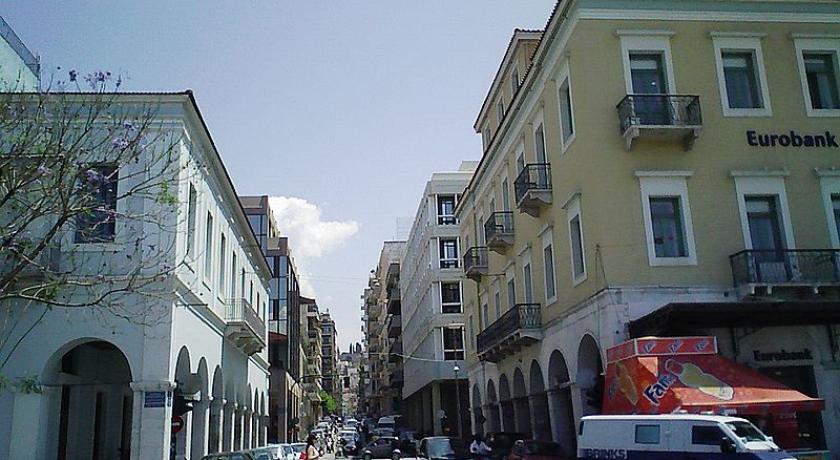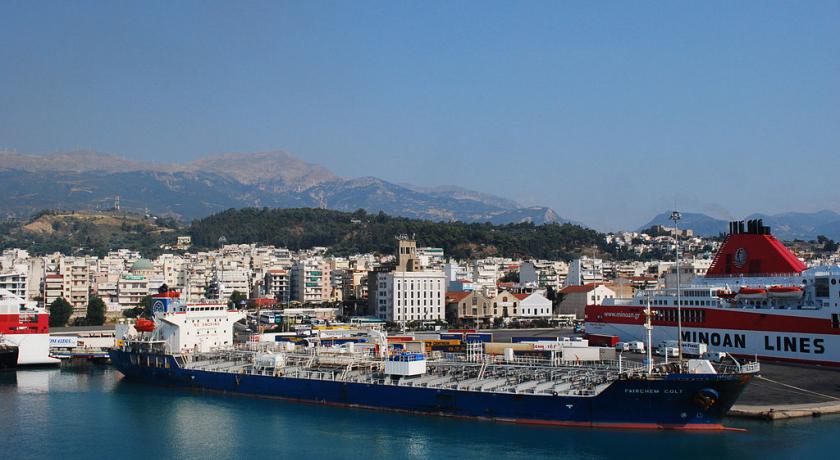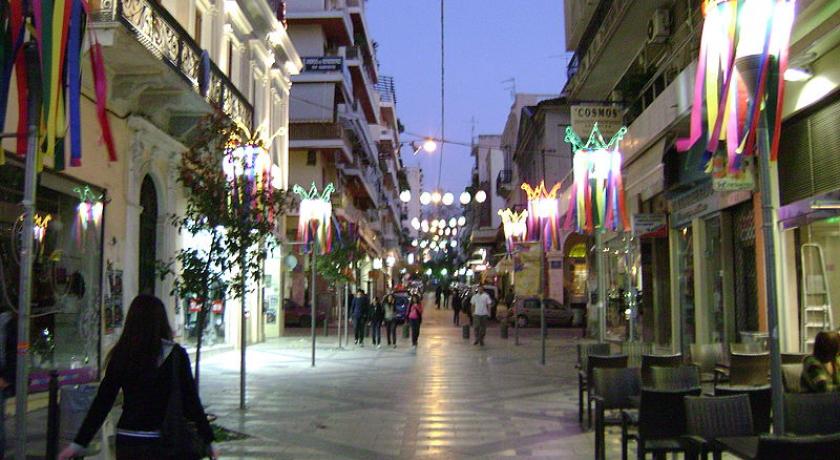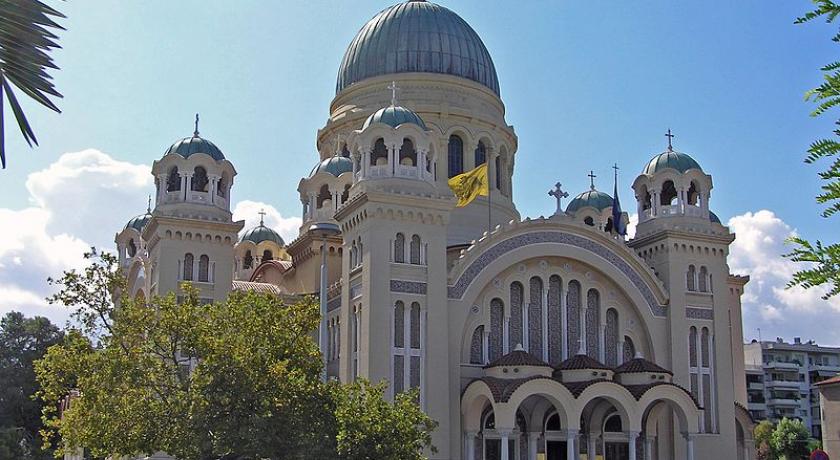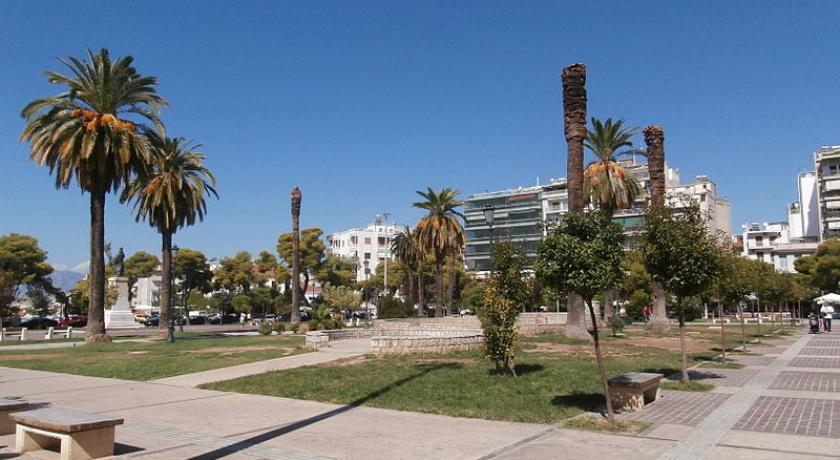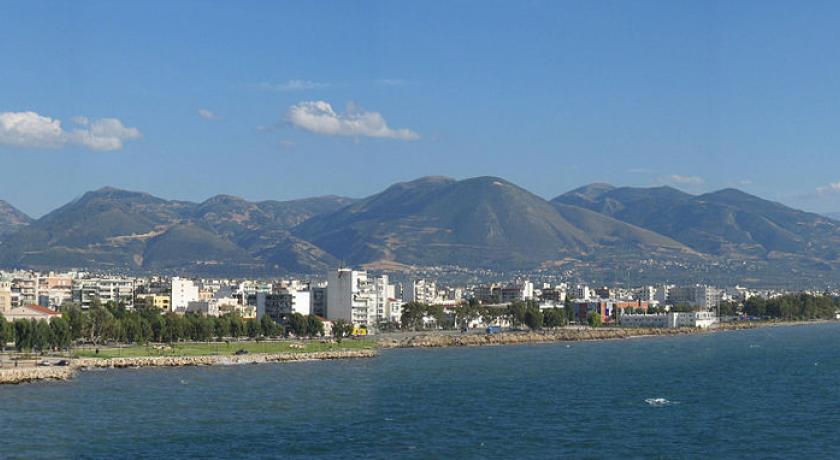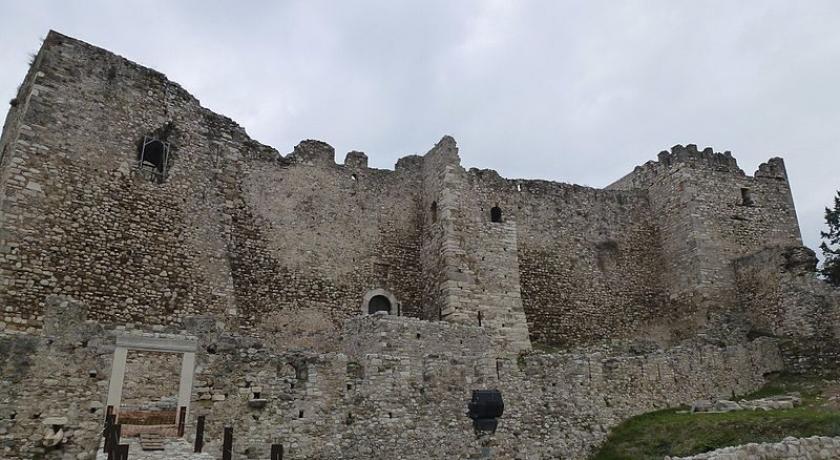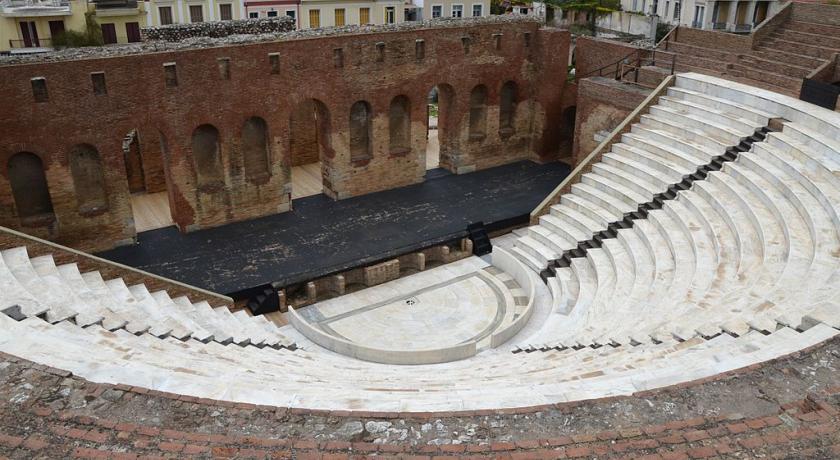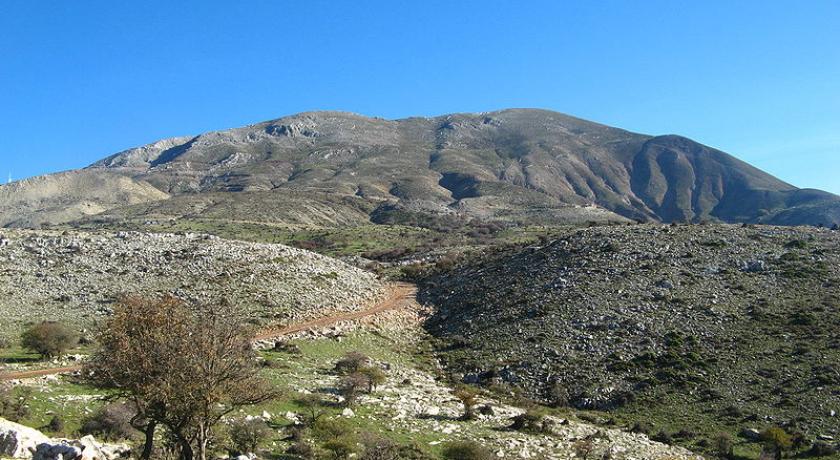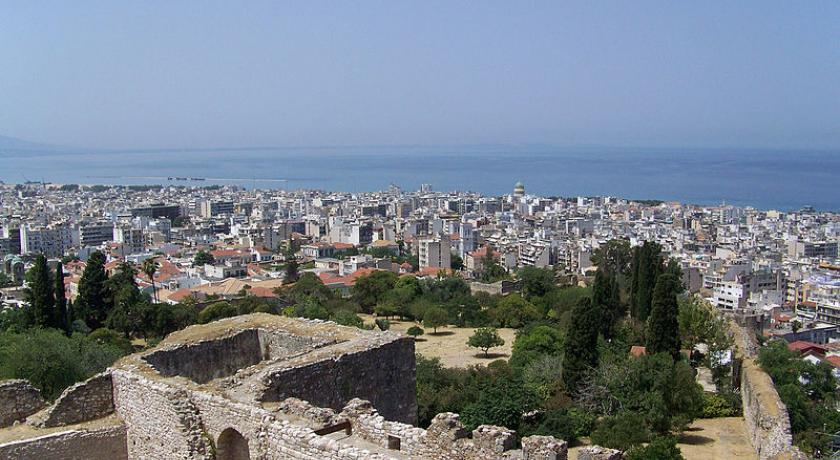Description
Patras (Modern Greek: Πάτρα, Greek pronunciation: [ˈpatra], Classical Greek and Katharevousa: Πάτραι (pl.), Greek pronunciation: [pátrai̯], Latin: Patrae (pl.)) is Greece's third-largest city and the regional capital of Western Greece, in the northern Peloponnese, 215 km (134 mi) west of Athens. The city is built at the foothills of Mount Panachaikon, overlooking the Gulf of Patras.
Patras has a population of 213,984 (in 2011). The core settlement has a history spanning four millennia; in the Roman period it had become a cosmopolitan center of the eastern Mediterranean whilst, according to Christian tradition, it was also the place of Saint Andrew's martyrdom.According to the results of 2011 census, the metropolitan area has a population of 260,308 and extends over an area of 738.87 km2.
Dubbed as Greece's Gate to the West, Patras is a commercial hub, while its busy port is a nodal point for trade and communication with Italy and the rest of Western Europe. The city has two public universities and one Technological Institute, hosting a large student population and rendering Patras a major scientific centre with a field of excellence in technological education. The Rio-Antirio bridge connects Patras' easternmost suburb of Rio to the town of Antirrio, connecting the Peloponnese peninsula with mainland Greece.
Every year, in February, the city hosts one of Europe's largest carnivals: notable features of the Patras Carnival include its mammoth satirical floats and balls and parades, enjoyed by hundreds of thousands of visitors in a Mediterranean climate. Patras is also famous for supporting an indigenous cultural scene active mainly in the performing arts and modern urban literature. It was European Capital of Culture in 2006.
Geography
Patras is 215 km (134 mi) west of Athens by road, 94 km (58 mi) northeast of Pyrgos, 7 kilometres (4 miles) south of Rio, 134 km (83 miles) west of Corinth, 77 km (48 miles) northwest of Kalavryta, and 144 km (89 mi) northwest of Tripoli.
A central feature of the urban geography of Patras is its division into upper and lower sections. This is the result of an interplay between natural geography and human settlement patterns; the lower section of the city (Kato Poli), which includes the 19th-century urban core and the port, is adjacent to the sea and stretches between the estuaries of the rivers of Glafkos and Haradros. It is built on what was originally a bed of river soils and dried-up swamps. The older upper section (Ano Poli) covers the area of the pre-modern settlement, around the Fortress, on what is the last elevation of Mount Panachaikon (1,926 m (6,319 ft)) before the Gulf of Patras.
Urban landscape
The city is divided into the upper and the lower section, connected with roads and broad stairs. The upper section (Ano Poli) is the older and the more picturesque; however, the lower section (Kato Poli) is laid out according to the 1858 city plan, featuring a variety of squares. The most notable of these are the Psila Alonia and the Georgiou I Square. A number of notable neoclassical buildings are to be found, including the Apollon Theatre in Georgiou I Square, the 'Town Hall, the headquarters of the Local Trade Association and the Court of Justice. A replica of Patras Lighthouse, the city's emblematic old lighthouse - which was at the dock of Ayios Nikolaos - rises at the end of Trion Navarhon street, near the temple of Saint Andreas.
In general, much of Patras' coastline is framed by roads and avenues running alongside; these include Dymaion Coast to the south and Iroon Polytechneiou Road to the north.
Main sights
Patras and its region is home to various Ancient Greek, Roman and Byzantine Monuments, including the Roman Odeon, the Fortress of Rio and the Fortress (castle) of Patras. More specifically, the main sights of the city are:
- The Roman Odeon, the most significant ancient monument, is in the upper town and was built around 160 AD, in the reign of either Antoninus Pius or Marcus Aurelius. It has been restored and partially reconstructed, and is used as an open-air theatre for performances and concerts in the summer.
- The medieval Patras Castle, in the ancient acropolis overlooking the city, was initially built in the 6th century AD by the Byzantine emperor Justinian, having many additions from the period of the Frankish and Venetian rule of the city, up to as far as the time of the Despotate of Morea and later the Ottoman Empire. Its current outline dates back to the second Venetian rule of the town (1687–1715). Today, its interior is used as a public garden.
- The Roman Amphitheatre, near the Roman Odeon, in Ifestou street, dating from the 1st century AD, at a period of the biggest development of Roman Patras. Its area has been only partially excavated.
- The church of Saint Andrew of Patras was founded in 1908 by King George I and was inaugurated in 1974. It is dedicated to Saint Andrew, the patron of the city and is near the seafront, between the areas of the new and the old port. It is the second-largest temple of Byzantine style in the Balkans (after the Cathedral of Saint Sava in Belgrade). The central cupola is 46 m (151 ft) tall and is the base for a 5-metre (16 ft) gold-plated cross and twelve smaller ones, symbolising Christ and the twelve apostles. A congregation of at least 5,000 can attend a sermon within the church.
- The municipal Theatre Apollon, built in 1872 to plans by the German architect Ernst Ziller. The building is characteristic of the 19th-century neoclassical style and is in the central square of the city.
- The Achaia Clauss wine industry and tasting center, which is on the outskirts in Petroto village. It was founded in 1861 by the Bavarian Gustav Clauss and is most famous for its Mavrodaphne.
- The Patras Archaeological Museum exhibits the history of Patras from the prehistoric era to the late Roman period.
- The Roman aqueduct that led from the springs of Romanos to the acropolis. The aqueduct measured 6.5 km (4.04 mi) from the water cistern to the castle. For the greater part of this distance, the water passed through an underground channel, passing over valleys and gorges on carefully constructed archways, parts of which still stand, in the area of Aroi.
- The Roman bridge over the river Milichos, which dates from 114 AD.[citation needed] It is in Agyia, in the northern suburbs of the city, at the junction of Aretha street and the National Road.
- The Turkish baths building (16th century), in Boukaouri street, still retain their initial use, and are one of the few Turkish baths surviving in Europe.
- The Patras Lighthouse, a reconstructed "Faros" (Lighthouse), which is the symbol of the city. The lighthouse is situated at the seaside front between the old and the new port, at the end of Trion Navarhon street.
- The Agiou Nokolaou Stairs, Gerokostopoulou Stairs, Patreos Stairs and Trion Navarchon Stairs, outdoor grand staircases all over the centre of the city dividing the upper town from downtown.
Parks and squares
- Georgiou I Square, the central square and the heart of the city. It was named after king George I. The square's fountains were installed in 1875 at a cost of 70,000 drachmas each, a huge amount for the finances of Greece and Patra at the time. It was and continues to be the center of political and cultural life in the city, hosting all significant activities, political gatherings, rallies, cultural events and, most importantly for some, its carnival.
- Ethnikis Antistaseos Square (Olga's Square) is known by the name of queen Olga, wife of king George I, and was planted with trees bearing the name "The queen's garden". Today the square is officially known as Ethnikis Antistaseos, but its old name (Olga's Square) is the one in most regular use.
- Trion Symmahon Square bears the name of the three Allied Powers who fought for the liberation of Greece; Britain, France and Russia. The square features a flower clock and links the Ayiou Nikolaou pedestrian way with the seaside front and the dock of Ayios Nikolaos.
- Psilalonia Square (Greek: Ψηλαλώνια or formally Πλατεία Υψηλών Αλωνίων) is one of Patras's most popular squares. It is 1.5 km (0.93 mi) from downtown Patras, next to the city's main north-south street, Gounari Street. It features a fountain, many sidewalks, palm trees and playgrounds. A bronze statue of Germanos of Patras stands on the northern end, while a memorial plaque to people executed in the Axis occupation of Greece stands on the south-western corner. It is surrounded by several shops, restaurants and cafes and a number of modernist buildings. It was completed in the mid-to-late 19th century, when trees were added, along with neoclassical buildings. After World War II and the Greek Civil War, however, and through the 1960s and 1970s, most neoclassical buildings were replaced by eight-storey residential buildings. In the west end, a 15-metre-tall (49 ft) cliff overlooks the Trion Navarchon pedestrian street, and offers a wide vista across the western Gulf of Patras, including the mountains of Aitoloakarnania.
- The Spinney of Patras (Greek: Δασύλλιο), is in a pine-tree-covered hill, which is dubbed "the Gulf of Patras' veranda" because of the panoramic view it offers. The spinney is ideal for recreational walks and jogging, with its specially formed paths and the shade offered by the tall trees. The pine trees that cover the spinney were planted in March 1916 by students of Patras' primary schools under the supervision of the Austrian forest specialist Steggel.
Architecture
The city is endowed with a number of neoclassical buildings and mansions dating from the late 19th and early 20th centuries. In the past, years of neglect and the absence of protection enforcement, as well as recent earthquakes, had contributed to the destruction of several such examples. Today, however, most surviving neoclassical buildings are under a strict protection status. As a part of the 2006 European Capital of Culture programme, there was a project for the restoration of the city's architectural heritage.
Patras' center is characterised by a composition of architectural currents and trends. Α representative example are the façades around the central square of the city (Georgiou I square). The neoclassical Apollo Theatre, a work of Ernst Ziller, is next to the modernist building of the Hall of Literature and Art (Μέγαρο Λόγου και Τέχνης), while the majority of the unattractive multi-storey buildings on the west and south side of the square were constructed in the late 1960s and 1970s.
Today's Patra is a relatively newly built city, as its medieval buildings were completely destroyed in the Greek War of Independence. The oldest surviving buildings (apart from ancient monuments and the castle) are the church of Pantocrator in Ano Poli and a residential building (Oikia Tzini) at the corner of Ayiou Nikolaou and Mezonos street, built in 1832. The area on the south of the castle, around the Roman Odeon and the church of Pantokrator, in the Upper Town (Ano Poli), is the most appealing of the city, because of its status as the only area where construction height is limited to two-storey buildings.
Infrastructure
In the past, Patras lacked public investment in infrastructure; in recent years, this trend has changed significantly. Several important works have been recently completed to serve Patras as an Olympic city, a European capital of culture and one of the most populous Greek cities.
Other heavy infrastructure works include the Peiros-Parapeiros dam (to provide water supply for Patras and surrounding towns) and a "small industries" park that will be constructed next to the Glaykos river and provide an easy connection with the new port.
The city is one of the main Greek internet and GRNET hubs and is connected with high speed lines to Athens as part of the backbone. A metropolitan optical network will be deployed in the city, with a total length of 48 km (30 mi).
Two major state hospitals operate in the city: the Agios Andreas Hospital is the oldest of the two; and General University Hospital of Patras. There also exists two smaller state hospitals, Karamandanio - a children's hospital, and the Center of Chest Diseases of Southwestern Greece. The Greek army also operates the 409 army hospital in the city. A large range of private hospitals and clinics operate in parallel.
Numerous art venues and an ultra-modern archaeological museum were constructed for the needs of European Culture Capital designation. The cultural and educational facilities include the Municipal Library, the university libraries, many theatres, the municipal art gallery, the University of Patras's facilities, the Hellenic Open University and the Technical Institute of Patras. A number of research facilities are also established in the university campus area.
Culture
The cultural activity of Patras includes the Patras International Festival (with various artistic activities, mainly in the fields of theatre and music), the Patras Carnival and the Poetry Symposium.
The city hosts many museums, including the Patras Archaeological Museum, the History and Ethnology Museum, the Folk Art Museum, the Press Museum and the Technology Museum, the latter in the campus of Patras University.
Other cultural institutes are: the Visual Arts Workshop, the icon painting school, the Carnival Float Workshop, the Municipal Library, the Municipal Gallery, along with many private art galleries. The architectural heritage of the city is dominated by neo-classicism, but also includes structures from other periods. Patras is also a pilot city of the Council of Europe and EU Intercultural cities programme.
Theatrical tradition and music
The Patras Municipal and Regional Theatre was founded in June 1988, having as its main stage the city's landmark, the Apollon Theatre. Throughout its existence it has mounted critically acclaimed performances ranging from ancient dramaturgy and modern Greek, to international repertoire. The theatre cooperates with other theatrical groups, such as the Viomichaniki (Industrial) group and the Michani Technis (Art Machine). The Roman Odeon hosts ancient dramas in the summer, while the Pantheon theater, the Art Factory, the Lithographeion and the Agora theatres provide additional venues. The International Festival of Patras takes place every summer, with a program consisting mostly of plays—both ancient drama and modern theatre—as well as various musical events.
Patras has also a very strong indie rock scene with critically acclaimed bands such as Raining Pleasure, Abbie Gale, Serpentine, Doch an Doris and others. The city is also the birthplace of Karagiozis (shadow theatre) in Greece, with Dimitris Sardounis as founder.
In addition, there are several conservatoires and music schools, including one devoted exclusively to Byzantine music, several orchestras and choirs.There are also a number of dance schools, and there are plans to set up a dance theatre within the context of the Patras Municipal and Regional Theatre. The latter hosts a full-time professional theatre group, while there are several amateur groups performing in the city.
Carnival
The Patras Carnival (Patrino karnavali) is the largest event of its kind in Greece and one of the biggest in Europe, with a heritage reaching back 160 years. The events begin in January and last until Clean Monday.
European Capital of Culture 2006
Patras was chosen by the European Commission to be the European Capital of Culture for the year 2006. The concept of the event revolved around the main theme of "Bridges" and "Dialogues", drawing benefit from the city's rich history and its position as a "Gate to the West", to underline the essence of the productive interaction of culture and civilisations in Europe. The EU Commission found Patras' plans very ambitious and also commented that a successful hosting of the title by a medium-sized city would make it possible to redefine the meaning of the term Cultural Capital.
The Selection Panel for 2006 noted in its final report:
The current cultural activity of the city includes the Patras International Festival (various artistic activities, mainly in the field of music), the Patras Carnival and the Poetry Symposium (organised each year for the 25 years by an ad hoc committee at the University of Patras). The Patras 2006 proposal focuses on two central ideas: "bridges" and "dialogues". Cultural managers from Patras and the general public will be involved in developing these ideas. Further, four poles/programmes of cultural attraction will be developed. The first, "A city for Europe", will relate to the architectural heritage, the industrial revolution and similar subjects. "The counterpart cities" programme will be developed in the fields of human and social sciences and in diverse artistic fields. "The three sea battles" will present a cultural programme focusing on peace and understanding. The last theme, "The many homelands", is directly linked to the etymology of the name of the city. This programme will among other things concentrate on art workshops, the transfer of know-how, way of life and entertainment.
In 2006 various cultural events were held in the context of the European Capital of Culture. Among the artists presenting their work in Patras were: Gary Burton, Maxim Shostakovich, Ian Anderson - with the Patras Municipal Orchestra, Jean Louis Trintignant, Roberto Benigni, Eros Ramazzotti and José Carreras. With the completion of the Capital of Culture programme, a part of the old Ladopoulos factory was renovated to host exhibitions, a small theatre (named the Art Factory), was built and a number of neoclassical buildings around the city were renovated as part of a plan to preserve the city's architectural heritage and link it to its cultural life. The new Archaeological museum was completed in 2009. Its globe-like roof and modern architectural design enhances the town's northern entrance, taking its place among the other city landmarks.
Sports
Patras has several sports facilities and important teams in almost all the major Greek leagues. Panachaiki Gymnastiki Enosi, Apollon Patras, E.A. Patras and NO Patras are historically the major sports clubs based in the city, specialising in football, basketball, volleyball and water polo. The city's national stadium, Pampeloponnisiako Stadium, was renovated and expanded in 2004. Since 2009, a new event, the Patras International Circuit Kart takes place every September, turning the city streets into a circuit.
The city has hosted several international sports events, such as the 1995 Basketball Under-21 World Championship (preliminaries), the 1995 Men's European Volleyball Championship (preliminaries), the 1997 Rhythmic Gymnastics European Championships, the 2001 World Wrestling Championships, the 2003 European Women Basketball Championship, the 2003 International Children's Games, a group stage of the football tournament in the 2004 Olympic Games, the 2007 World Rhythmic Gymnastics Championships, the 2008 World Deaf Football Championships.
Transport
Seaport
The city has always been a sea-trade hub because of its strategic position. The port manages more than half of the foreign sea-passenger transportation in Greece, and has excellent car-ferry links with the Ionian islands and the major Adriatic ports of Italy. Additionally, a new port is under construction in the southern section of the city to accommodate the increased traffic and relieve the city centre from port operations.
In 2011, the new harbour (southern port) went into operation. Ferries to Italy now dock there.
The port is connected by a number of daily routes to the Ionian islands Kerkyra, Kefallonia and Zakynthos, to the port of Igoumenitsa and to the Italian cities Ancona, Bari, Brindisi, Trieste and Venice. Seaplanes also operate.
Roads
A newly constructed, 20-kilometre (12 mi) ring road (the Bypass of Patras) was first opened in 2002 in order to alleviate heavy traffic throughout the city. A mini ring road (known as the "Mini bypass" of Patras) is now being constructed to alleviate heavy traffic-related problems in the city centre. Two large highways are under construction that will connect the seacoast and the new port with the Bypass of Patras. The first is over the small Diakoniaris river (from Eleftheriou Venizelou street until the Bypass'es exit in Eglykada), while the second consists of two roads, 4 km (2 mi) each, that will run in parallel with the Glafkos river. Another project will lead to an additional entrance to the downtown area by expanding Kanakari street.
The highway connection with Athens and Pyrgos is to be greatly upgraded. Patras will also be the central hub of the Ionia Odos highway, intended to bridge western Greece from Kalamata to Ioannina. The Rio-Antirio bridge is north of the city and links Peloponnese to mainland Greece, and was completed in August 2004.
Patras is bypassed by the Olympia Odos (A8) motorway, which is also part of the E55 route that crosses the Rio-Antirio Bridge, dominating the sealine across the Gulf of Corinth.
- GR-5/E55
- GR-8/E55 and E65 (partly Panepistimiou Street)
- GR-8A
- GR-9/E55 (partly Akti Dymaion)
- GR-33 (partly Kalavryton, Georgiou Papandreou Street and Akrotiriou)
- Bypass of Patras
Rail
A rudimentary single, narrow gauge railway track crosses the city and connects it to Athens and to Pyrgos-Kalamata, while the central passenger train station lies to the west of the downtown area, between Aghiou Nikolaou Street and Othonos-Amalias Avenue. The main freight station of Aghios Andreas lies further to the south, next to the homonymous church. Finally, the old depot of Aghios Dionysios, consisting of about ten tracks, offers basic turntable and roundhouse facilities; it is about 400 m (1,312.34 ft) long. A new standard gauge railway to Korinth and further to Athens is under construction.
Regional rail links were until 2010 provided by the Hellenic Railways Organisation, connecting to Athens and Piraeus as well as to Pyrgos and Kalamata. However all services were suspended in December 2010 on cost grounds.
Public transport
within the city of Patras is served by buses. There are two transport lines to and from the University of Patras, and some nearby lines to the city suburbs, like Saravali, Zarouchleika, Paralia.
Commuter rail services have recently been established by Proastiakos, with one line currently connecting Patras, Rio and Agios Vasileios. The plan is eventually to connect to Kiato, from where the main Proastiakos already runs to Corinth, Athens, and Athens International Airport.
Regional bus links are provided by KTEL, connecting the city to almost the entire Greek territory and to places inside the province of Achaea.
Air
Seasonal air transport is provided at Araxos airport, about 40 km (25 mi) from the city.
History
Middle Ages
In the Byzantine era Patras continued to be an important port as well as an industrial centre. One of the most scholarly philosophers and theologians of the time, Arethas of Caesarea was born at Patrae, at around 860. By the 9th century there are strong signs the city was prosperous: the widow Danielis from Patras had accumulated immense wealth in land ownership, the carpet and textile industry, and offered critical support in the ascent of Basil I the Macedonian to the Byzantine throne.
In 1205 the city was captured by William of Champlitte and Villehardouin, and became a part of the principality of Achaea. It became the seat of the Barony of Patras, and its Latin archbishop primate of the principality. In 1408, Patras became Venetian, until it was recaptured in 1430 by the Despotate of Morea and its despot Constantine Palaiologos, who thus succeeded in recovering for the Byzantine Empire the whole of the Morea, apart from Venetian possessions. The administration of Patras was given to George Sphrantzes, while Constantine was immediately contested by the Ottoman Empire and later, in 1449, became emperor of the Byzantine empire.
Patras remained a part of the Despotate of Morea until 1458, when it was conquered by the Sultan of the Ottoman Empire, Mehmet II. Under the Ottomans, it was known as Baliabadra, from the Greek Παλαιά Πάτρα ("Old Patras"), as opposed to Νέα Πάτρα, the town of Ypati in Central Greece. Though Mehmet granted the city special privileges and tax reductions, it never became a major centre of commerce. Venice and Genoa attacked and captured it several times in the 15th and 16th centuries, but never re-established their rule effectively, except for a period of Venetian rule in 1687–1715.
Modern era
Patras was one of the first cities in which the Greek Revolution began in 1821; but the Turks, confined to the citadel, held out until 1828. The city was liberated on 7 October 1828 by the French expeditionary force in the Peloponnese, under the command of General Maison. The new city was planned under the supervision of Stamatis Voulgaris after Ioannis Kapodistrias order.
Patras developed quickly into the second-largest urban centre in late-19th-century Greece. The city benefited from its role as the main export port for the agricultural produce of the Peloponnese. Patras was also a gateway for emigration to the USA (most notably following the “raisin crisis” of 1920 which devastated the local economy).
In the early 20th century, Patras developed fast and became the first Greek city to introduce public streetlights and electrified tramways. The war effort necessitated by the first World War hampered the city's development and also created uncontrollable urban sprawl after the influx of displaced persons from Asia Minor after the 1922 population exchange between Greece and Turkey. In the Second World War the city was a major target of Italian air raids. In the Axis occupation period, a German military command was established and German and Italian troops stationed in the city. After the liberation in October 1944, the city grew fast to recover, but in later years was increasingly overshadowed by the urban pole of Athens.
Address
Patras
Greece
Lat: 38.246109009 - Lng: 21.735742569


